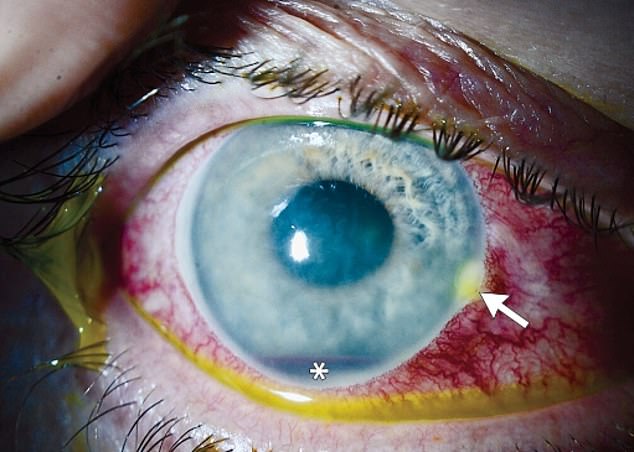A 55-year-old Philadelphia man was nearly blinded after a bee stinger became lodged in his eyeball and had to be forcibly removed with tweezers.
The man went to the emergency room with “worsening vision and pain” and the stinger was quickly identified, but doctors were unable to fully remove it as it was embedded in the edge of the iris, or the colored part of the eye.
Two days later, the man was admitted to Wills Eye Hospital in Philadelphia, still in pain and virtually blind in his right eye.
Further tests revealed the man was suffering from dangerous bleeding inside his eye and damage to small blood vessels.
The side of the eye closest to the nose still had part of the stinger lodged in it, which appeared yellow after the eyes were stained, as shown by an arrow in the image.

The doctor removed the remaining part of the stinger with jeweler’s pliers, but his eye remained swollen and he needed follow-up care from an ophthalmologist.
Doctors discovered the damage using a detailed eye examination using a slit lamp and fluorescein dye, highlighting any damage by turning it yellow-green.
He had redness in the white part of his eye, known as conjunctival injection.
He also had severe swelling in the lower part of the cornea, the clear, dome-shaped front part of the eye that covers the iris, pupil and anterior chamber.

The stingers are tiny, but doctors took a picture at 100 times magnification
The side of the eye closest to the nose still had part of the stinger lodged in it, which appeared yellow after the eyes were stained, as shown by an arrow in the image.
Additionally, there was bleeding inside the eye, likely caused by damage to the iris from the stinger and bleeding from the iris vessels, shown by an asterisk on the image.
The stingers are tiny, but doctors took a photo at 100 times magnification.
They range in size from 1.5 to 3 mm (approximately one-sixteenth to one-eighth of an inch).
Doctors prescribed the man antibiotic eye drops and drops containing prednisolone, a corticosteroid used to treat inflammation.
They said, ‘At 5 months follow-up, visual acuity in the right eye had improved to 20/25.’
Bee stings to the eye are rare and few case studies describe them.
The stingers have barbs that allow them to pierce tissue and lodge in the eye.
Typically, when the stinger is removed from the bee’s body when it embeds itself in a person’s skin, or in this case, their eye, most of the bee’s innards are removed and the bee dies.
Bee, wasp and yellow jacket stings contain venom.
The venom can cause significant damage to the cornea, iris and retina, potentially leading to blindness.
That damage can also lead to scarring, another potential cause of vision loss.

